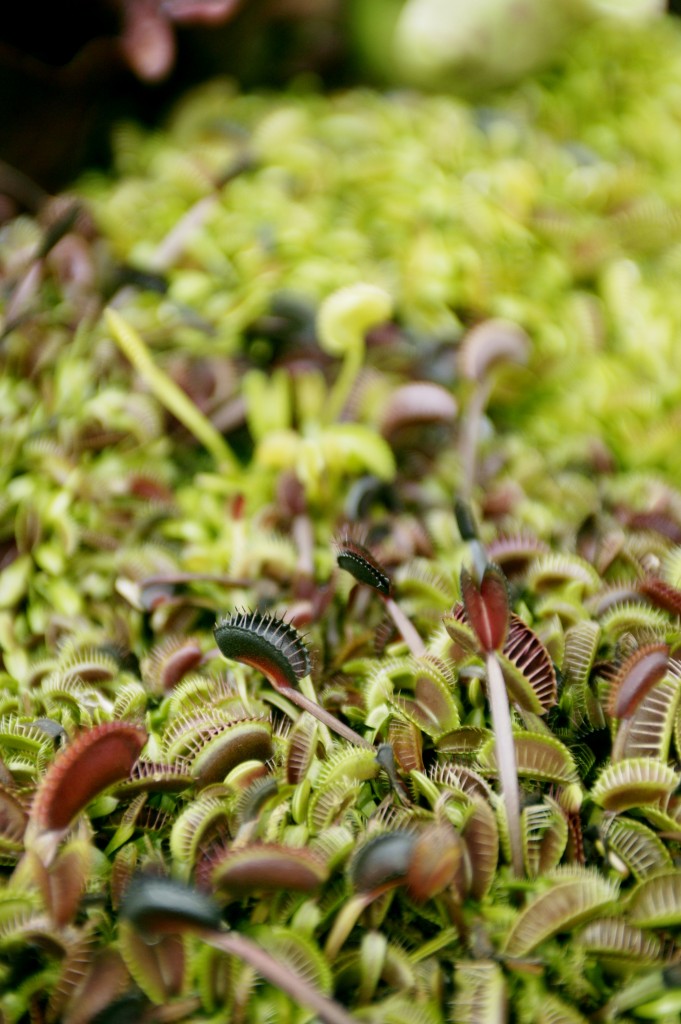The world is full of weird and bizarre plants, but the most strange and bizarre would have to be the carnivorous plants. It’s amazing to think of plants trapping living creatures, and slowly digesting them. If you saw the movie “The Day of the Triffids” you probably thought the idea of plants eating all the humans and taking over the world was a bit far fetched. Well, think again – maybe it wasn’t all that far from reality.
Don introduces us to carnivorous plants, the different kinds available, how to care for them, and some great ideas for growing them in containers.
Types of Carnivorous Plants:
Venus fly trap (Dionaea muscipula)
There is only one species in the genus Dionaea, and it’s the most popular of the carnivorous plants. The hinged leaves have stiff spines along their margins, and glands which secrete insect-attracting nectar. When tiny sensitive hairs inside the leaves are touched twice within about twenty seconds, the mechanism is activated and the leaf closes. The trap then tightens and seals around the victim, and enzymes are released to begin the digestive process, which can take anything up to a week. Although it’s fun to touch the leaves and see them close, don’t do it, because repeated false alarms can cause the traps to die.
Pitcher plants (Sarracenia sp. & Nepenthes sp.)
These plants catch insects in modified leaves, or pitchers. Some of the pitchers secrete nectar to attract their prey, and they’re often beautifully coloured in shades of purple, green, red or brown. Once an insect falls into the pitcher, it can’t get back out because the waxy sides are too slippery, and inside some pitchers there are downward facing hairs which prevent any escape. There are different kinds of pitchers, for example Sarracenia leucophylla is tall with red veins, and Sarracenia purpurea is low growing with small rosettes. Nepenthes are the climbers, and their pitchers sometimes grow to huge sizes, so large that monkeys in the jungle drink out of them, and they’re nicknamed Monkey Cups.
Sundews (Drosera sp.)
There are 54 species of Drosera, or sundew, in Australia. They have extremely sticky hairs on the surface of their leaves, which attract and catch insects. The process of digestion then begins, with some species actually curling the leaf over the insect. The sun sparkles on these little plants in the morning, hence the common name sundew.
Best look:
Carnivorous plants are great for containers, and the sort of container you use is only limited by your imagination. Don set up a little bog garden for children, using a cheap plastic boat purchased at one of the department stores. He filled it with peat, placed a climbing pitcher on the bow as the centrepiece, then planted some venus fly traps on the port and starboard sides. Another fun idea for the kids is to pop a venus fly trap into an ordinary coffee mug – easy, and it looks great. You could also use an old fish tank, or any glass or plastic container for a really special effect.
Care:
It is very important to use only distilled water or rain water on carnivorous plants, not tap water. They are sensitive to the impurities found in tap water.
Use Canadian or German peat moss for planting, Australian peats are not suitable. (Tip: before you use peat moss wet it thoroughly.)
There’s no need to fertilize carnivorous plants, they obtain their nutrients from the insects they catch.
They are outdoor plants, if growing inside, best position is a window with direct sunlight, and always keep water in their saucers.
Getting started:
Carnivorous plants are readily available, but you may have to order them through your local nursery. Average prices are $4-$20 for venus fly traps, $5-$10 for sundews, $7-$20 for pitcher plants and $12-$100 for climbing pitcher plants. Distilled water is available at service stations and supermarkets for around $2.15 per litre.



